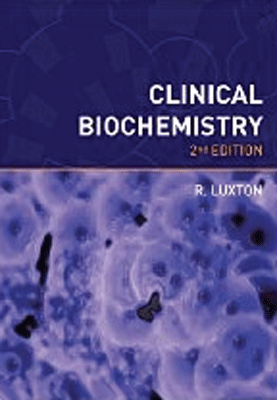Biochemistry
Biochemistry
₹895.50 ₹995.00 Save: ₹99.50 (10%)
Go to cartISBN: 9789387153523
Bind: Paperback
Year: 2018
Pages: 564
Size: 216 x 279 mm
Publisher: Scion Publishing Limited
Published in India by: Viva Books
Exclusive Distributors: Viva Books
Sales Territory: India, Nepal, Pakistan, Bangladesh, Sri Lanka
Description:
Preamble and Practice Tutorial Numerical Problems by S. N. Mukhopadhyay
Biochemistry by Terry Brown was conceived and written exclusively for introductory courses and is the ideal way to understand and learn this fascinating subject, whatever your background. It covers the key biochemical principles you will need to know whilst providing sufficient detail to allow a full appreciation of the subject.
Writing in the clear and concise style for which he is renowned, the author guides you through:
- the cells, organisms and basic biomolecules that are central to biochemistry
- the generation of energy and the key elements of metabolism
- the storage and reproduction of biological information, including DNA repair, protein synthesis and the control of gene expression
This edition has been designed for students and scholars in the Indian subcontinent specially keeping in view the course curricula in universities and other biochemistry courses. To make the book more user-friendly additional chapter-wise practice tutorial numerical problems have been included.
The book concludes with chapters describing the techniques used to study proteins, lipids and carbohydrates as well as DNA and RNA.
- The book includes a number of features to help you understand the subject:
- the basic principles are reinforced through real-world examples and applications
- key concepts in chemistry are detailed in separate boxes
- self-assessment questions in a variety of formats allow you to test your understanding
- practice tutorial numerical problems
Biochemistry - a concise and accessible text for students taking a course in biochemistry.
Contents:
Preamble
Preface
Abbreviations
How to use this book
Chapter 1: Biochemistry in the modern world • What is biochemistry? • Chemistry is also important in biochemistry • Box 1.1 The origins of biochemistry • Box 1.2 Schrödinger and biology • Biochemistry involves the study of very large biomolecules • Box 1.3 Atoms, isotopes and molecular masses • Biochemistry is also the study of metabolism • The storage and utilization of biological information is an important part of biochemistry • Biochemistry is an experimental science • Box 1.4 Omes are collections of biomolecules • Further reading
PART 1: Cells, organisms and biomolecules
Chapter 2: Cells and organisms • Cells the building blocks of life • Box 2.1 Units of measurement • There are two different types of cell structure • Box 2.2 Species names • Prokaryotes • Box 2.3 Bacteria communicate with one another in a biofilm • Box 2.4 The microbiome • Eukaryotes • What about viruses? • Box 2.5 Unusual types of infectious particles • Evolution and the unity of life • Life originated four billion years ago • Three and a half billion years of evolution • Box 2.6 Mass extinction events • Further reading • Self-assessment questions
Chapter 3: Proteins • Proteins are made of amino acids • Twenty different amino acids are used to make proteins • The biochemical features of amino acids • Box 3.1 Are there two versions of every amino acid? • Box 3.2 The ionization of water and the pH scale • Some amino acids are modified after protein synthesis • Box 3.3 Types of chemical bond • The primary and secondary levels of protein structure • Polypeptides are polymers of amino acids • Polypeptides can take up regular conformations • Box 3.4 The unusual characteristics of the peptide bond • Box 3.5 What is the difference between a left-handed and a right-handed helix? • Box 3.6 Predicting the secondary structure of polypeptide from its amino acid sequence • Fibrous and globular proteins • Fibrous proteins: keratin, collagen and silk • Globular proteins have tertiary and possibly quaternary structures • Box 3.7 Using collagen structure to identify extinct animals • Box 3.8 An example of a protein with a mixture of domains • Protein folding • Small proteins fold spontaneously into their correct tertiary structures • Protein folding pathways • Box 3.9 Studying protein folding • Protein folding is one of the fundamental principles of biology • Further reading • Self-assessment questions
Chapter 4: Nucleic acids • The structures of DNA and RNA • Polynucleotide structure • DNA and RNA secondary structures • Box 4.1 Base stacking • Box 4.2 The discovery of the double helix • Box 4.3 Sugar pucker • Box 4.4 Units of length for nucleic acid molecules • RNAs display a diverse range of chemical modifications • Packaging of DNA • Nucleosomes and chromatin fibers • Box 4.5 DNA packaging in bacteria • Further reading • Self-assessment questions
Chapter 5: Lipids and biological membranes • Lipid structures • Fatty acids and their derivatives • Box 5.1 Structural notation for fatty acids • Box 5.2 Essential fatty acids • Diverse lipids with diverse functions • Box 5.3 Polyterpenes • Box 5.4 Prostaglandins • Biological membranes • Membrane structure • Box 5.5 The carbohydrate component of a membrane • Membranes as selective barriers • Box 5.6 Voltage-gated ion channels and nerve impulses • Box 5.7 The biochemistry of cystic fibrosis • Further reading • Self-assessment questions
Chapter 6: Carbohydrates • Monosaccharides, disaccharides and oligosaccharides • Monosaccharides are the building blocks of carbohydrates • Box 6.1 Representations of monosaccharide structures • Box 6.2 The different types of isomers relevant to carbohydrate structure • Disaccharides are made by linking together pairs of monosaccharides • Box 6.3 Some humans have recently evolved the ability to digest milk • Oligosaccharides are short monosaccharide polymers • Polysaccharides • Starch, glycogen, cellulose and chitin are homopolysaccarides • Box 6.4 The reducing and non-reducing ends of a starch molecule • Heteropolysaccharides are found in the extracellular matrix and in bacterial cell walls • Further reading • Self-assessment questions





